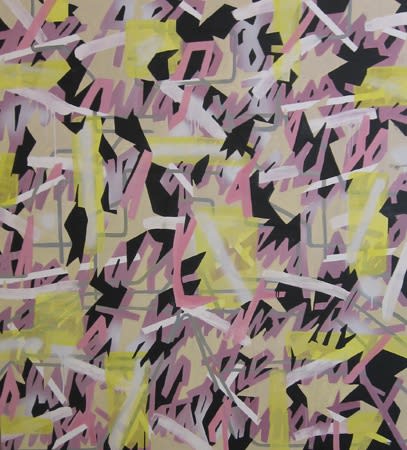half colors of quarter-things is a line from the Wallace Stevens poem “The Motive for Metaphor” – a poem about how language can never adequately describe experiences and how in order to describe events we must make metaphors, saying this experience was like something else…. and how the act of making metaphors, though creative, is a weakening, a step removed from the actual indescribable experience.
This failure to communicate is brought to the forefront in Farrar’s new series of large-scale, abstract paintings. Using text as a point of departure – quotes from poetry and theoretical texts scattered about the artist’s studio – Farrar works in a process-oriented manner, with each subsequent step in the painting used to negate the previous one. With the ultimate destruction of the text through abstraction, the paintings are unburdened by any attempt to “address” anything and exist on their own terms. The physical nature of this work directly references his past work abstracting the desolate urban landscape. However, these works grew out of a series of 23” square paintings of seemingly disparate images arranged stacked or in grids. The artist states “The main motivation for these multi-panel installations comes largely from reading poems and examining how poetry communicates. A line of poetry consists of words, each of which has their individual meaning. When combined, these meanings form concepts or images which are further nuanced by sound and rhythm which can either reinforce or negate the meanings of the words or create new images altogether that are perceived simultaneously. It is compelling how different images and concepts can exist simultaneously and interdependently in a single line or stanza; and, it is this presentation of connections that ultimately communicates something to the reader. This series of paintings is an attempt to explore such a “presentation of connections.”
With no preconceived agenda for subject matter, the series is made of representational images ranging from urban landscapes to machinery to anonymous prostitutes, hit-men and soldiers. Their placement creates a dialogue with each image reinforcing or negating the next, and to break up the cacophony the artist began in insert what he terms “generic abstract paintings” primarily as a utilitarian function used to break up the grid. These abstractions eventually grew into the larger text-based paintings. Underlying themes begin to emerge once these paintings are allowed to interact: war-destroyed cities as a metaphor for modern-day tracts of undesigned urban spaces, which in turn serve as a breeding-ground for anonymous city-created psychopaths; how this landscape denies active human interaction forcing inhabitants to fundamentally disconnect from their surroundings; how our interaction with machinery mediates, simulates, or interprets our experiences; how people who exist as participants in war become sub-human, an amalgam of man and machine, part cannon, part person; and how, if the landscape of war is an analog to the modern-day cityscape, we too are somehow sub-human.
Gabert Farrar (American b. 1972) holds a BFA from the University of Michigan and currently resides in Chicago. His work was featured at LISTE 05: The young art fair in Basel with moniquemeloche gallery and he has been in group exhibitions at Locust Projects (Miami), Paragraph Gallery (Kansas City), and in “I Feel Mysterious Today” at The Palm Beach Institute of Contemporary Art curated by Dominic Molon.

